Designing For Serenity: How To Create Calming Spaces With Abstract Art
In a world obsessed with speed, serenity has become a quiet form of rebellion. Our spaces should not just look good, they should feel like a deep exhale. Whether you’re designing a home, a studio, or a wellness centre, the way your environment holds you matters.
One of the most powerful ways to shape that atmosphere is through abstract art. Not decorative fluff, but art that speaks emotionally, art that breathes. Abstract pieces allow room for interpretation, reflection, and stillness. They meet people where they are, and they help bring them home to themselves.
In this article, we’ll explore how to use abstract art to design calm, emotionally intelligent spaces. Whether you’re styling a bedroom or rethinking a waiting room, this guide will walk you through colour, shape, mood, and placement, and how to use each to create true calm.
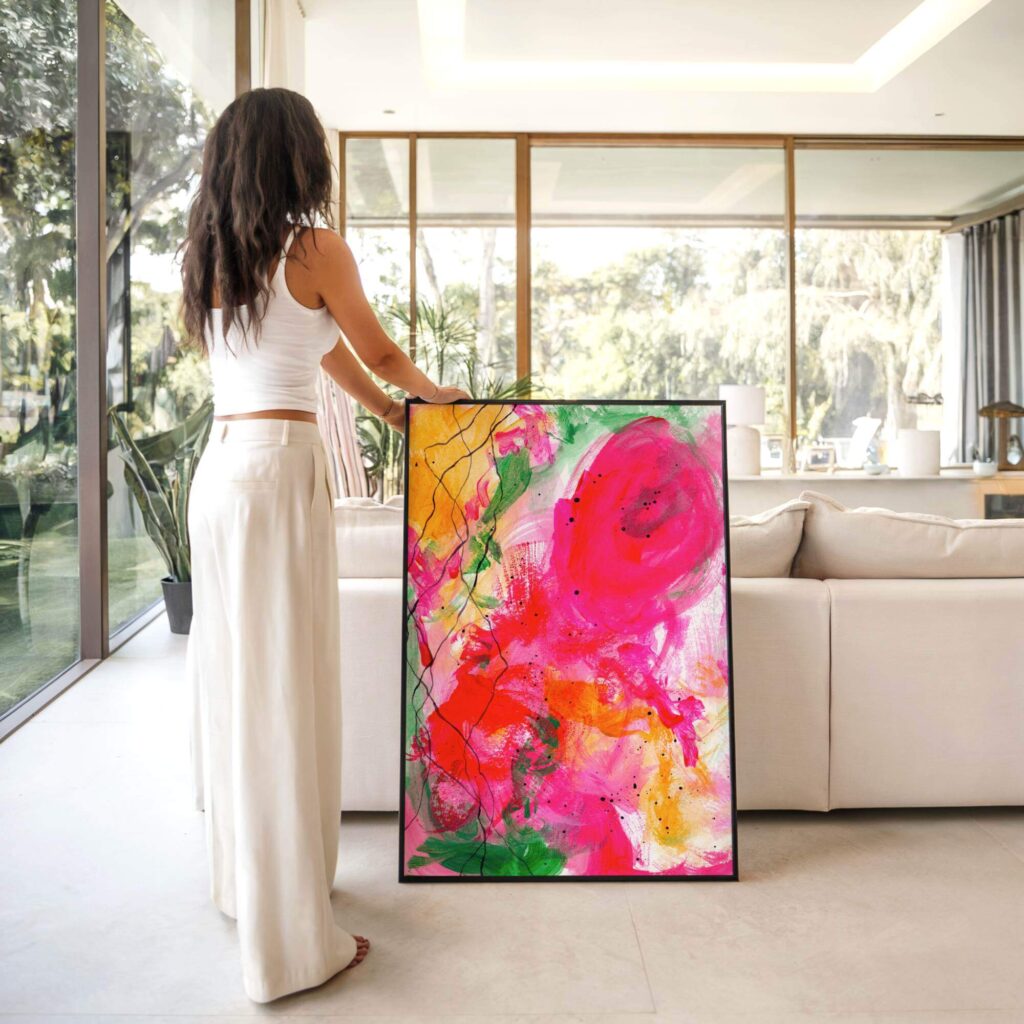
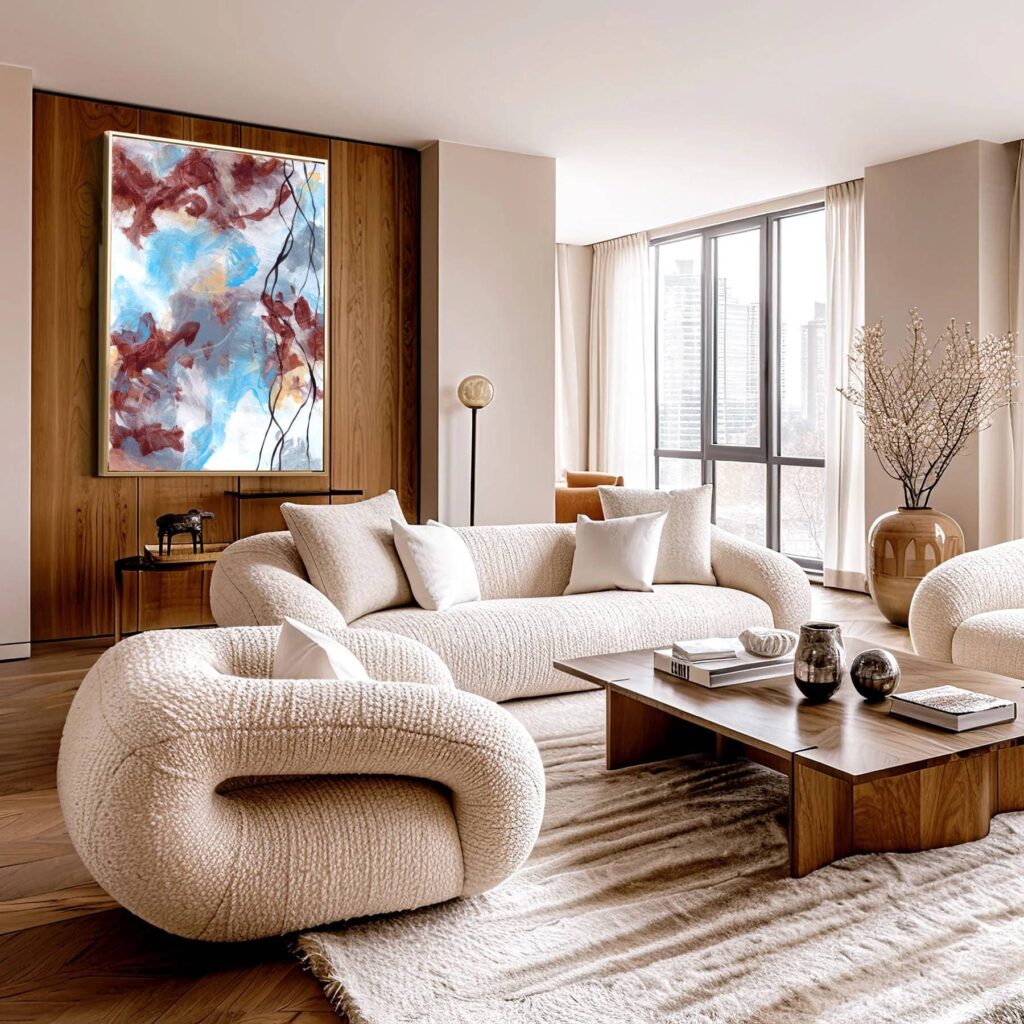
Why Abstract Art Works So Well in Calming Spaces
Abstract art is emotional architecture. It holds space without dictating meaning. Unlike literal artwork, which shows you exactly what to see, abstraction invites a quieter kind of looking, a gentle exploration rather than a reaction.
It removes pressure
When you enter a space and the art doesn’t demand your attention but softly supports your presence, your nervous system has room to settle. Abstract art offers just enough engagement to centre the mind without crowding it.
It connects without control
Because abstract pieces don’t represent specific scenes or objects, they allow people to respond from their own emotional reality. That makes them ideal in shared spaces, each viewer can take from the piece what they need.
It’s designed for mood, not message
Through intentional use of colour, form, and texture, abstract art can shift a room’s energy entirely. The right piece doesn’t just sit on a wall, it sets the tone.
Key Elements: Colour, Shape, Texture
Each part of an abstract piece plays a role in emotional tone.
Colour
Cool tones like blue, green, and soft grey help regulate the nervous system, encourage stillness, and support relaxation.
Earth tones like clay, sand, and muted ochre ground the space and create a sense of safety.
Warm neutrals like blush or dusty peach can soften clinical environments without overwhelming the eye.
Subtle contrasts – like a pale green against a deep brown, can add interest without chaos.
Shape
Soft curves and flowing lines encourage rest and openness.
Organic shapes mimic forms found in nature, helping the body feel more connected and less alert.
Minimal geometry can create structure without aggression when paired with softer textures.
Texture
Layered surfaces invite introspection.
Delicate brushwork or visible texture in canvas can add sensory depth, important in wellness spaces where tactility matters.
Flat, matte finishes reduce visual noise and reflect less light, which helps create calm in busy rooms.

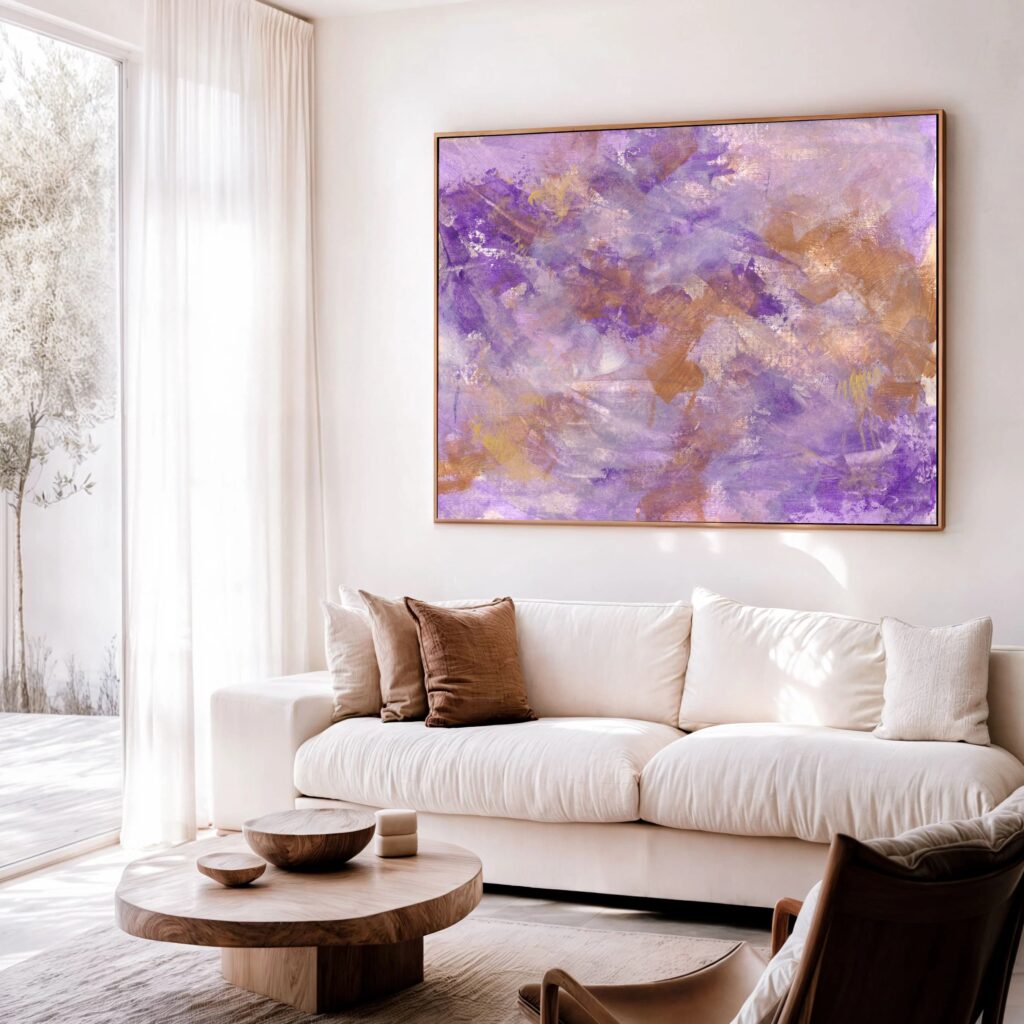
Creating Serene Spaces at Home
Your home should feel like a quiet permission slip to slow down. Abstract art can guide that feeling room by room.
Living Room: The Emotional Anchor
This is where your guests gather, where you decompress, where presence matters. A single large abstract piece, ideally one that stretches horizontally, can provide cohesion, presence, and a soft focus for the space. Think of it as visual breathing room.
Pair calming tones like mineral blue or foggy sage with open compositions that allow the eye to move slowly. Avoid chaotic brushstrokes or aggressive shapes here, serenity thrives in stillness.
Bedroom: Rest Without Clutter
Art in a bedroom should quiet the body. The best pieces for this space are not loud or emotionally intense. Think tonal work with subtle texture, something you can glance at before sleep and feel soothed, not stimulated.
Position the work where it’s visible from the bed. This isn’t about filling every wall. One well-placed canvas in gentle hues can act as a visual lullaby.
Home Office: Focus and Flow
Your workspace doesn’t need to be stark to be productive. Abstract art here can help separate work from rest without feeling sterile. Cooler tones like slate, soft green, or warm greys help you stay clear and calm.
Opt for minimalist compositions or monochrome palettes that won’t overwhelm your attention. And don’t underestimate the power of subtle movement, gentle shapes can support creative flow while keeping distractions low.


Using Abstract Art in Wellness Settings
Art in therapeutic or wellness environments should hold space for others. It should calm without crowding and support without stealing focus.
Spas and Relaxation Spaces
Clients come here to let go. Abstract pieces with soft gradients, gentle forms, and nature-inspired colours (moss green, ocean blue, stone grey) work beautifully. Avoid sharp contrasts or rigid geometry, they create alertness, not ease.
Install pieces where clients can see them while lying down or waiting. Let the art be part of the restorative process.
Therapy Rooms
Safety and openness matter here. Use abstract work that reflects gentle emotional depth, layered earth tones, subtle textures, curved compositions. Avoid work that’s too visually complex or emotionally charged.
The goal is to create an environment where people feel seen but not analysed, one that encourages presence, not pressure.
Meditation Rooms
Here, stillness is the point. Choose only one or two pieces at most. Go for spacious compositions with a lot of negative space. The colours should be soft but grounding, foggy blue, pale clay, soft charcoal.
Let the artwork serve as a soft focal point that enhances internal focus rather than pulling someone outward.
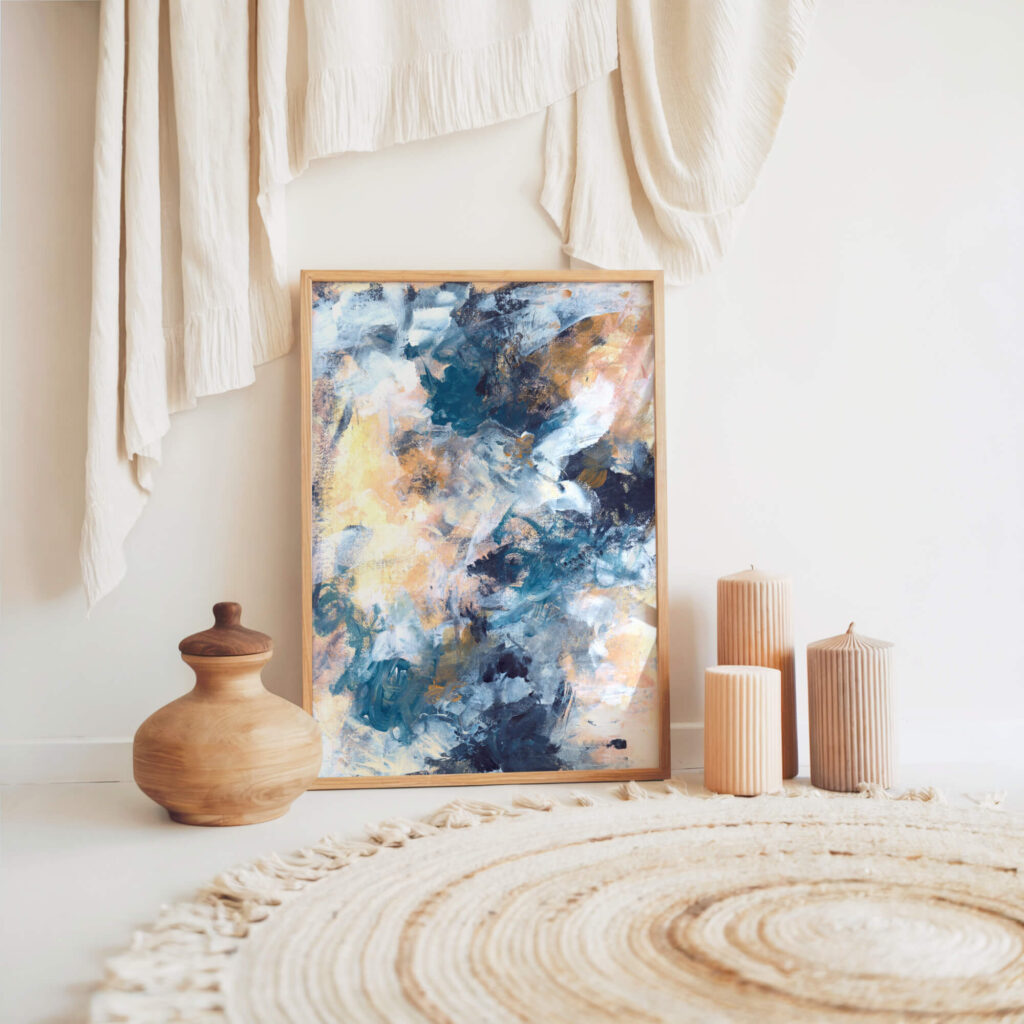
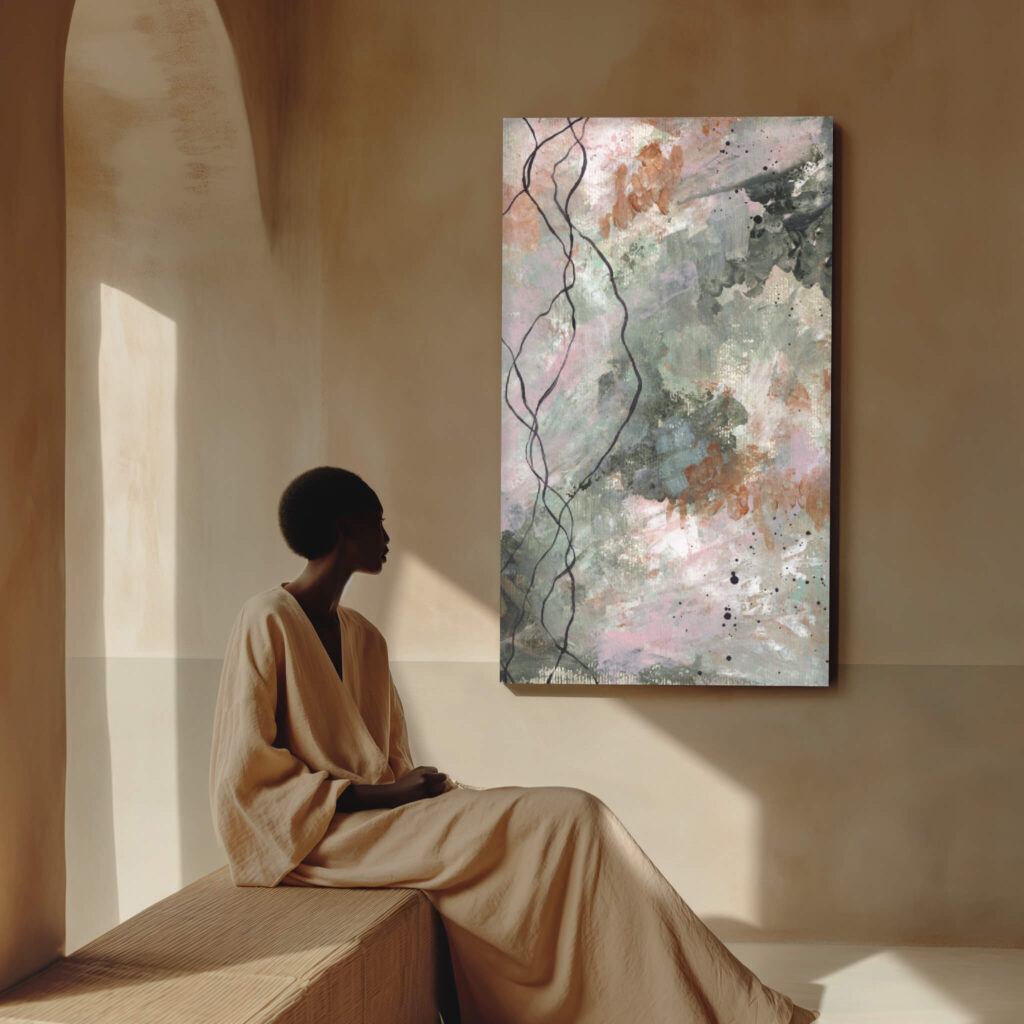
Abstract Art in Public and Professional Spaces
Serenity isn’t just for private retreats. Well-chosen abstract art in public-facing environments can create emotional ease in high-traffic or high-stress areas.
Waiting Rooms and Lobbies
Waiting is often stressful. But the right piece of art can soften the tension. Choose gentle, fluid forms in colours that reduce overstimulation, think sage, taupe, cloud white.
Avoid anything too intricate or bright. This isn’t the place for bold reds or chaotic patterns. The art should meet people in a moment of pause and help them breathe more deeply.
Corporate Offices and Boardrooms
You can have both presence and calm. Abstract art in these spaces should carry a sense of structure, think line-based compositions or minimal geometrics, but without harshness.
Black and white with a touch of gold, or deep navy with soft greys, can create gravitas without making the room feel heavy. In collaborative rooms, art that uses symmetry and balance can foster focus and clear communication.
Creative Studios
Here, energy and inspiration matter. You can push a little more. Choose bold compositions with movement, but maintain emotional intention. Colourful abstract work that still feels cohesive and intentional can help fuel momentum without tipping into chaos.


How to Curate the Right Piece for Your Space
Curating abstract art isn’t about filling space. It’s about choosing presence over pressure.
Ask yourself:
What should this room feel like?
Who uses this space, and what do they need emotionally?
Where does natural light fall?
Do I want art that disappears into the space or leads the atmosphere?
Then:
Choose quality over quantity: one powerful piece can do more than a gallery wall.
Let the art breathe: give it space around the frame. Clutter kills calm.
Match your intention, not your sofa: art isn’t an accessory. It’s an atmosphere.
My Offerings
Whether you’re a private collector, a wellness-focused brand, or a designer sourcing for a high-calibre project, I offer art that resonates deeply and subtly.

Collector's Vault
Canvas prints from the archive, made with emotional resonance and sustainable materials for spaces seeking depth.

Capsule Commission
Created privately, one at a time, through stillness and reflection. Limited spaces each season to preserve depth and intimacy.
The Last 10
Ultra-limited, hand-embellished editions. No more than ten will ever exist. Made to ground, steady, and hold presence at the highest tier.
Final Thoughts: Art as Emotional Infrastructure
You don’t need a full redesign to create a calmer space. Sometimes, all it takes is one piece of art that understands what the room is for.
Abstract art isn’t decoration. It’s a form of emotional design. It shapes the way a space feels, how it holds people, and how it allows presence to rise.
If you’re creating a space that soothes, steadies, or re-centres, this kind of art is not optional. It’s the pulse of the room.
If you’re building a space that soothes and steadies, you’re welcome to explore the art behind this atmosphere.
Quiet, intentional pieces, available in limited canvas editions, are waiting here: https://vikithorbjorn.art/collectors-vault/
Frequently Asked Questions About Creating Calming Spaces With Abstract Art
Abstract art softens the mind’s tendency to analyse. Because it does not depict literal scenes or objects, it allows the nervous system to downshift. The body stops scanning for meaning and starts settling. Good abstract art creates a quiet visual rhythm, which supports stillness and helps a room feel more grounded.
Cool tones like soft blue, deep green and gentle grey regulate the nervous system. Earth-based tones like clay, sand and muted ochre create safety and warmth. Warm neutrals like blush or dusty peach soften sharper spaces. The key is restraint. Calming palettes rely on harmony, not contrast.
Curves, flowing lines and organic forms. They mimic nature and help the body feel more open, less guarded. Minimal geometry can work too, as long as it is gentle and not rigid. Sharp angles, hard diagonals and high-impact patterns create alertness rather than ease.
Place it where the eye naturally goes first. That becomes the emotional entry point of the space. In living rooms, this is usually above the sofa. In bedrooms, it is visible from the bed. In therapy rooms or wellness spaces, place it where people rest, wait or breathe. The art should support them, not perform for them.
Bigger pieces often feel calmer because the eye has fewer elements to negotiate. One large work can anchor a room more effectively than several small ones. For narrow spaces, tall vertical pieces create length and quiet. For smaller rooms, choose a piece with breathing space inside it. Calm comes from coherence, not scale alone.
Yes. Calming artwork helps regulate attention and emotional load. It gives the mind a soft focus point, which can lower physiological tension. In wellness environments, abstract art is often used intentionally to support rest, reduce overwhelm and create emotional safety.
Avoid works with frantic lines, aggressive marks or highly saturated colours like neon red. Also avoid heavy visual clutter, harsh geometry, or intense contrast. These activate the nervous system instead of settling it. Serenity comes from gentleness, cohesion and emotional clarity.
Choose artwork with softness, space and subtle movement. Look for pieces that feel like breath rather than noise. Cool tones, muted palettes and gentle shapes work well. The art should support rest, not stimulate the mind. In meditation rooms, one or two pieces are enough. Stillness needs space.
Absolutely. Calm is not the opposite of professionalism. Offices, boardrooms and lobbies benefit from art that steadies the room. Choose structured but gentle compositions, minimal colour palettes and shapes that support clarity. This creates a grounded atmosphere without losing presence.
- Does this piece help my breathing slow down?
- Does it soften the room rather than compete with it?
- Does it feel settled rather than chaotic?
- Would I want to sit near it on a difficult day?
